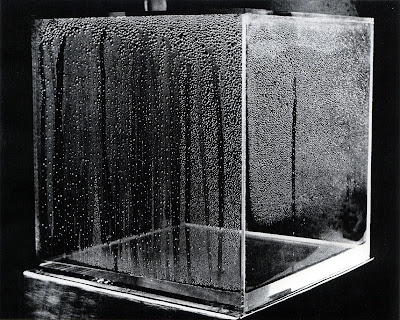Condenstation Cube, 1963-65
An early exploration of systems and processes, both natural and institutional. In the discourse of institutional critique, the piece may be read as criticism against the closed system of the museum or gallery which attempts to control and contain.
Hans Haacke’s Condensation Cube (1963-65) is a hermetically sealed, clear acrylic plexiglass box, thirty centimeters on the side that holds about one centimeter or so of water. Condensation collects against the inner surface of the plexiglass forming vertical streaks on the inside. How the condensation is created can be explained in the following way: Air can hold only a limited amount of water vapor and when that limit or dew point (a law of nature, which applies to all bodies of air all over the world) is reached, condensation occurs. In almost all art museums, the temperature is set at a cool 65 degrees Fahrenheit, which means that at a relative humidity of about 45 percent (the standard in most museums), the dew point is at 42 degrees. Because plexiglass is a bad thermal insulator, the air temperature inside the Cube is the same as the temperature on the outside, namely 65 degrees. But since the humidity is close to 100 percent, the dew point is much higher, and is, in fact, about 65 degrees, precisely the temperature of the plexiglass.

No comments:
Post a Comment